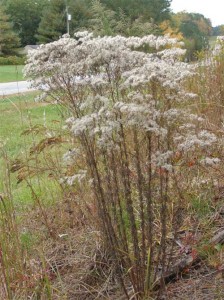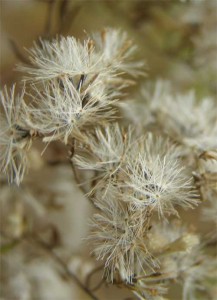Oh, no; not another Eupatorium!
By Ken Moore
Remember that large genus of wildflowers in the aster (composite) plant family with the scientific name referring to some ancient king who thought one of the species was a poison antidote? Back in August, I described the many merits of boneset, Eupatorium perfoliatum, and more recently, two more Eupatoriums, flat-topped, blue flowered ageratum and the towering, feathery dog-fennel.
Please have patience as I indulge in describing another Eupatorium. I begin noticing it in early August, when the characteristic flat-topped inflorescences, the term for a plant’s flowering branch structure, begin bud formation. Single multi-stemmed plants or whole populations of them begin calling attention to themselves along the roadsides, where not in the path of frequent mowing.
Standing one to two feet tall, they look like puffy little clouds hovering just above the ground. Well, that’s the image I pull up whenever seeing them, and I enjoy weeks of roadside viewing as they gradually turn from pale-green to pure-white when they reach full flowering in September-October. Now as we move into the early weeks of winter, those plants are still attractive as grayish dried arrangements that last into the dead of winter. All three developmental stages of this plant are effective as a base or filler for flower arrangements.
This Eupatorium hyssopifolium, hyssopleaf Eupatorium, copies the leaf arrangement pattern of its namesake, the holy herb, hyssop. The short narrow leaves scattered up and down the stems usually have fascicles (tight clusters) of smaller leaves emerging from the leaf axils. I recall my delight decades ago when I learned to observe that “fascicled-leaves-along-the-stem†characteristic of this Eupatorium; until then they looked to me like any other roadside plant.
I remain in awe that plants like the whole group of Eupatoriums crowd so many tiny flowers into those variously structured inflorescences. It’s remarkable how many different insect pollinators are attracted to those flower heads. Our admiration should not stop with the flowers.
A closer look at the seed heads of those various Eupatoriums reveals, crowded together, thousands of single little seeds, little nutlets, called achenes by botanists. An even closer look with your hand lens, which I hope you always carry with you, will further reveal that each of those seeds are crowned with a ring of filament-like hairs.
These are the “parachutes†that carry those seeds aloft for wind dispersal. Now think about nature’s efficiency with this strategy. First of all, those seed plumes, so interlocked as they are, prevent all those seeds from being dispersed at once. You will notice that some of those seeds will hang on for weeks. That’s a plus for birds foraging during late fall and winter, and don’t be concerned for the plants; there are so many seeds produced that enough of them will gradually take flight on the winds to establish new plants near and far.
There are other Eupatoriums out there that we may not have noticed, but they are all being noticed by pollinators and seed-eating critters. And don’t fear, I won’t describe any more. I believe during the past few weeks, we’ve taken a closer look at the most engaging and useful of them.




Comments are closed.